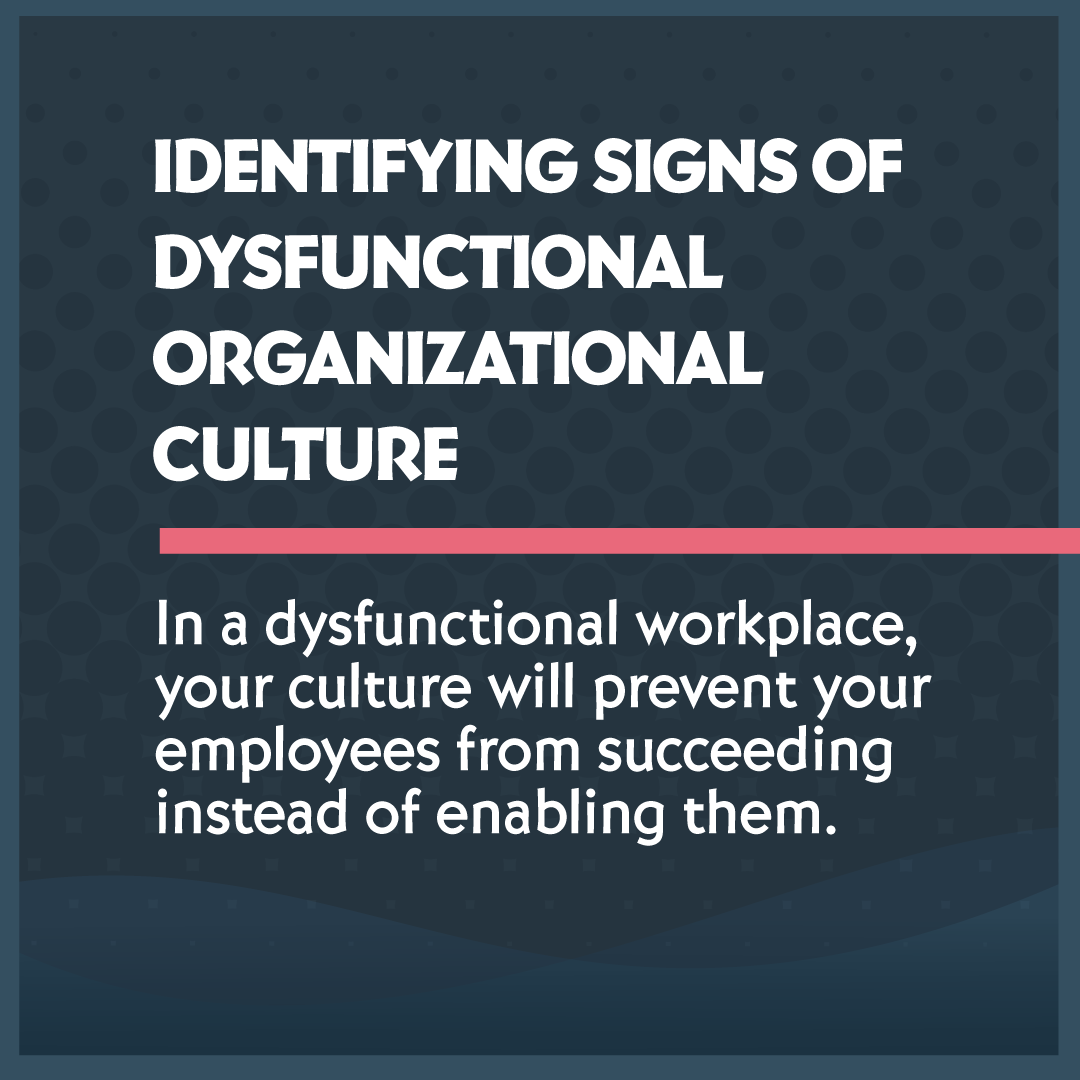Identifying Signs Of Dysfunctional Organizational Culture

What is dysfunctional organizational culture?
To discuss dysfunctional organizational culture, let's first address what corporate culture is. Indeed describes culture as "a collection of attitudes, beliefs, and behaviors that make up the familiar atmosphere in a work environment. Healthy workplace cultures align employee behaviors and company policies with the company's overall goals while also considering the well-being of individuals."
While culture makes up a variety of factors, the end impact is a healthy environment for your employees to do their best work. In a dysfunctional workplace, your culture will prevent your employees from succeeding instead of enabling them.
Consider going on a run. If you are running in nature with fresh air, it will be easier to finish your run than in a city with smog. Your external environment impacts your ability to perform, and the analogy lends itself well to company culture. Organizational leaders need to create a clean environment (specifically within various teams and departments) that allows employees to perform better - by focusing less on ego drama and more on getting work done.
When is organizational culture considered dysfunctional?
 A company’s culture is considered a dysfunctional workplace when the cultural norms get in the way of productivity and goals. There are many ways that a negative organizational culture can manifest, such as dysfunctional workplace management, but the outcomes are similar. There is a dysfunctional corporate culture when the behaviors and systems encourage competition within teams, discourage trust, and not enable psychological safety. These sometimes unspoken aspects of culture prevent employees from feeling safe enough to take risks, thus limiting their creativity.
A company’s culture is considered a dysfunctional workplace when the cultural norms get in the way of productivity and goals. There are many ways that a negative organizational culture can manifest, such as dysfunctional workplace management, but the outcomes are similar. There is a dysfunctional corporate culture when the behaviors and systems encourage competition within teams, discourage trust, and not enable psychological safety. These sometimes unspoken aspects of culture prevent employees from feeling safe enough to take risks, thus limiting their creativity.
Let's keep these differences in mind as we explore signs of a dysfunctional culture.
What are signs of corporate dysfunction?
Corporate dysfunction arises in the behavior of leaders and employees and often shows up within team dynamics. Four common patterns of dysfunctional workplace behaviors set the wrong tone for success. We've taken these patterns and identified them as specific modes of behavior. Observing and coaching to mitigate these problems can help create an agile organizational culture, which can also become generative.
Here are four signs of organizational dysfunction in teams:

- Power-seeking and dominant behavior
When people on a team start to become competitive, idea sharing and trust levels are often reduced. When this happens, they stop working as a team and can even work against each other. An example of this could be when one salesperson begins to fight over additional territory, which takes away from another salesperson, who is technically on the same team but would lose out.
- Status-seeking and diminishing behavior
If an individual on a team starts to seek ways to be superior to others, they wind up demotivating those around them instead of having an open mind and learning from others. This diminishing behavior results in people spending excessive time seeking titles, elite awards, or other personal forms of status instead of contributing to the team at large.
- Approval-seeking and blaming behavior
Approval-seeking behavior can show up in the form of inauthenticity. A practice of being nice on the surface (while gossiping negatively behind the scenes) is really about wanting to be liked. This blaming behavior happens when someone has an unconscious need for approval from others, staying silent instead of voicing potentially unpopular opinions. The behavior backfires and contributes to dysfunction since their insights could have helped the team as a whole.
- Attention-seeking and fabricating behavior
If someone on the team is interested in being recognized as exceptional at the expense of their team members, they can find themselves striving to be a favorite rather than operating as a team player. The result can be seen as self-serving, which erodes trust and creates a divisive environment where teams cannot find common ground or move forward.
How are dysfunctional companies different from agile companies?
In a dysfunctional organization, the organization's negative company culture hinders the company's goals, but in an agile company, the culture acts as a catalyst for the company to go beyond. Negative organizational culture holds people back and impacts their customer, too, but an agile culture allows companies to get out of their employee's way so that they can create and innovate. The crucial difference lies in the culture. Anyone who thinks it doesn’t matter is unaware of how much results are driven by emotional undertones and human interaction.
As Peter Drucker said, “culture eats strategy for breakfast”.
Tips for creating corporate agility
A culture of agility results in a balanced and healthy team that positively impacts the job of each team member. We have a previous blog that covers this topic in more depth, but some of the tips for creating a culture of corporate agility include:

- Transparency
Using project management tools such as Trello, Asana, or Jira can help enable clear communication and transparency. These tools allow people to establish workflows and identify obstacles that block success quickly. Transparency also helps create a high level of mutual accountability among others, which is crucial.
- Clear Expectations
Understanding your goals is essential, but identifying specific OKRs is the next step to help create clear expectations among others. By creating OKRs that are tangible, one can make clear expectations with tasks. An example of an unclear expectation is a goal to "grow social media presence," which is vague. Creating a plan such as "increase Facebook followers from 5,000 to 6,500 followers" which is more specific and enables tracking for success.
- Trust & Responsibility
Unfortunately, many leaders still think that people will slack off if they are working remotely. We believe differently, and hiring the right people makes the difference. If you hire self-motivated people who are responsible, then it's appropriate to trust them to report responsibly on their work efforts. If we employ mature adults, we should treat them this way. If they don’t act like adults when empowered, then move to performance management measures, so they grow new character strengths.
- Social Connection
Everyone wants to feel like they are part of a strong team or group. Spend some time during your weekly meetings to create connections among your team members. Connecting with others can be as simple as asking everyone about recent personal news. Celebrate the victories that people achieve outside of work - your recognition that they are human beings living meaningful lives outside of work is valuable.
In closing, dysfunctional organizational culture is something that needs to be closely monitored by leaders to ensure they do not produce these behavior patterns in their business. The issues can be detrimental to progress and result in a loss of agility. If you want to create a cleaner environment for your team to be successful, you need to focus on creating a culture of corporate agility and generativity, which inspires people to put in extra discretionary effort beyond what they might have done without it. All because you’ve cared enough to make a change to build a culture where people love to work.




